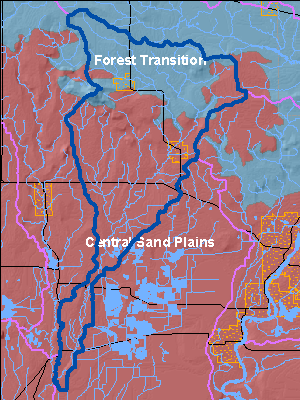
Details
The Hemlock Creek Watershed is located in Wood and Juneau counties. This watershed was ranked using the Nonpoint Source Priority Watershed Selection Criteria. Based on surface and ground water data, the overall ranking is high. This overall ranking establishes the watershed as a high priority for grant eligibility through the Nonpoint Source Program.
Several cranberry marshes exist within the Hemlock Creek Watershed. Presently, the Department lacks information in regards to water quality impacts that are a result of surface water discharges from the cranberry bogs. There is a concern that contaminants from fertilizers and pesticides are being discharged from various nonpoint sources that may be degrading water quality and harming sensitive aquatic species. Additional monitoring is recommended to determine affects of agriculture to this watershed.
The Wood County Soil Erosion Control Plan ranked this watershed third priority out of 10 watersheds for NPS control management needs. Soil erosion in the towns of Arpin and Hansen located in the upper portion of the watershed cause severe impacts to the overall water quality of the watershed.
Date 2002

Ecological Landscapes
The Central Sand Plains Ecological Landscape, located in central Wisconsin, occurs on a flat, sandy lake plain, and supports agriculture, forestry, recreation, and wildlife management. The Ecological Landscape formed in and around what was once Glacial Lake Wisconsin, which contained glacial meltwater extending over 1.1 million acres at its highest stage. Soils are primarily sandy lake deposits, some with silt-loam loess caps. Sandstone buttes carved by rapid drainage of the glacial lake, or by wave action when they existed as islands in the lake, are distinctive features of this landscape.
The historic vegetation of the area included extensive wetlands of many types, including open bogs, shrub swamps, and sedge meadows. Prairies, oak forests, savannas and barrens also occurred in the Ecological Landscape. An area of more mesic forest with white pine and hemlock was found in the northwest portion, including a significant pinery in eastern Jackson County. Today, nearly half of the Ecological Landscape is nonforested, in agriculture and grassland. Most of the historic wetlands were drained early in the 1900s and are now used for vegetable cropping. The forested portion is mostly oak-dominated forest, followed by aspen and pines. A minor portion is maple-basswood forest and lowland hardwoods.
Date 2010
Monitoring & ProjectsProjects including grants, restoration work and studies shown below have occurred in this watershed. Click the links below to read through the text. While these are not an exhaustive list of activities, they provide insight into the management activities happening in this watershed.
Watershed RecommendationsWI Rapids Storm Water Management Plan Update
Date
Status
This project is an installation of nonpoint source best management practices to contribute to the restoration of Wisconsin's waters and was funded by the 319 grant. Storm water planning activities will be undertaken by the municipality and will result in the following products: updated storm water management plan for the developed urban area.
1/1/2016
In Progress
Hemlock Creek TP
Date
Status
2013 TP: "Insuf Data: Prelim Result-Clearly Exceeds". Missing a September sample. Station 10016616. AU 18327. Miles Possible TP listing in 2020. Other AU is already listed for TP.
5/1/2018
Proposed
Wisconsin Rapids, Wood County
Date
Status
SSA Planning and Updates for Wisconsin Rapids
4/1/2011
In Progress
 Watershed History Note
Watershed History NoteArpin is a village in Wood County in the Hemlock Creek watershed and was the site of an early twentieth century agricultural settlement of Jewish families from Europe. The German philanthropist Baron Maurice de Hirsch had become concerned about the plight of European Jews who were migrating in increasing numbers to large cities. He established the Industrial Removal Office to settle Jewish people families into what were seen as more healthy environments. The Milwaukee branch of the office was the Milwaukee Jewish Industrial Aid Society headed by Adolph Walter Rich, Milwaukee merchant, manufacturer, and philanthropist. The Town of Arpin had originally been established by the Arpin Brothers Lumber Company, but as nearby trees were cut and the saw mill ceased operations, there were both houses and land available. The society purchased 720 acres of land near Arpin, and Rich eventually added additional acres. Each family was to be assigned a forty acre tract with livestock, implements, a suitable dwelling, and funds to cover incidental expenses. A foreman was to be appointed to supervise the settlement. It was to be "a true Zion" in Wisconsin "on a moderate scale."
On 1 December 1901 the first five families arrived. More followed. Many of the new settlers were from Russia. By May 1906, the new settlers had cleared an average of ten acres each and had begun to produce crops of corn and vegetables and to cut cord wood. With the money from these crops the settlers were able to begin payment of interest owed to the society. Rich made frequent trips to Arpin. In 1915 a Jewish house of worship was built. A strong feeling of community developed among the settlers and they got on well with their Christian neighbors. The number of people in the settlement was never large, about seventy or eighty people at most, almost of all of whom were engaged in agriculture. In the 1920s people began to drift away; bitterly cold winters, better paying jobs in nearby cities, and the difficulties of anyone in Wisconsin trying to making a living on a small farm were all factors in the slow decline of the colony.
Date 2010